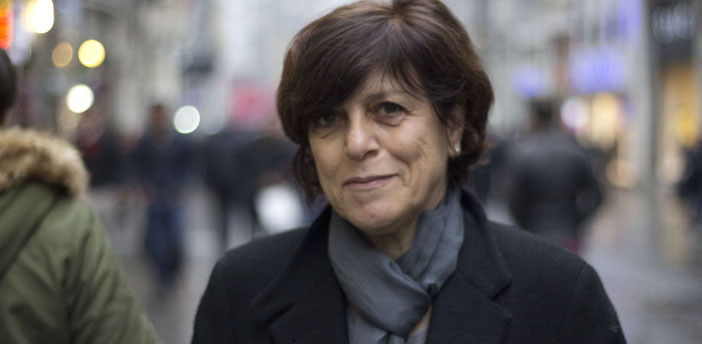‘İnsanın rezilliğinin defilesi’


Ahmet İnsel ve Kerem Ünüvar’ın editörlüğünde, İletişim Yayınları’ndan çıkan kitap, çeşitli yazışma, hatırat, konsolosluk raporu ve tanıklıklara dayanarak, kıyımların gerçekleştiği yerlerin detaylı çalışmasını, soykırımın 19. yüzyılın sonundan Türkiye Cumhuriyeti’nin kuruluşuna kadar süren safhalarını, tüm yönleriyle ele alıyor.
Yaklaşık 200 sayfalık dipnotlarla toplam 1167 sayfa olan bu başyapıtın Türkçeye çevrilmesi, 2,5 yıl sürmüş. Ayşen Taşkent Ekmekçi’yle, çeviri sürecini ve kitabın Türkçe yayımlanmasının önemini konuştuk.
Öncelikle, kitabı çevirme sürecinde neler hissettiğinizi merak ediyorum.
Hâkim olan duygu, utançtı. Çok değerli bir çalışma, aynı zamanda çok yıpratıcı. Nefes alamadığım, sık sık pencereyi açtığım, ağladığım, çeviriyi bıraktığım zamanlar oldu. Kötülüğün sınırının olmadığını gördüm ve insanlık adına utandım. Bu topraklarda yapılan kötülüğün boyutundan, bu kadar geç haberdar olduğum için utandım.
Kitabın Fransızca ve İngilizce basımı arasında bazı farklar olduğu söyleniyor. Siz hangisini temel aldınız?
Sayılarla ilgili bazı farklılıklar vardı. Kévorkian’la konuştuğumda, ana metinde Fransızcayı, dipnotlarda İngilizceyi baz alabileceğimi söyledi. İki dildeki çeviriyi karşılaştırarak çevirdiğim için, hata payı daha aza indi. Çeviri bittikten sonra da birkaç kere kontrol ettim.
Bu kitabın, konuyla ilgili yapılmış diğer çalışmalardan en büyük farkı nedir?
Bu kitabın farkı, çok çıplak bir biçimde, her şeyi anlatması… Ayrıca, verdiği detaylar açısından da çok değerli. İnsanın rezilliğinin defilesi gibi. Her kötülüğün bir fazlası var, sonu gelmiyor. Şimdiye kadar okuduklarım, bilgi aktarımıydı. Bu kitapta, tanıklıklara geniş yer veriliyor.
Kitabın en çok hangi kısımlarında zorlandınız?
Çocuklarla ilgili olan bölümlerde çok zorlandım. Çocukların kazılan kuyulara doldurulması, yetimhanelerde yaşadıkları zorluklar, büyük bir sefalet ve açlık içinde, yarasındaki kurdu çıkarıp yemeyi düşünenler… Çok ağır geldi bana.
En çok etkilendiğiniz bölüm neresiydi?
20 bin Ermeni’nin Kilikya’da öldürüldüğünü bilmiyordum. Hep 1915’e odaklanıldığı için, Adana Katliamı geri planda kalıyor. Ayrıca, Dersim’de olanlar beni çok etkiledi. Dersim’e kaçmayı başaranlar kurtuluyor. Özel durumdan ötürü devlet, Dersim’e giremiyor. Öte yandan, Dersimliler gelenleri koruyor, bırakmıyorlar.
Çeviri sürecinde ek araştırmalar yaptınız mı?
Bazı şeylerden emin olabilmek için, konuyla ilgili çok okuma yaptım. Taner Akçam’ın neredeyse bütün kitaplarını, Kévorkian’ın Aras Yayıncılık’tan çıkan, ‘1915 Öncesinde Osmanlı İmparatorluğu’nda Ermeniler’ kitabını okudum. Enver Paşa, Talat Paşa, Teşkilat-ı Mahsusa’yla ilgili; tüm aktörler, bölgelerle ilgili çıkmış kitapları, makaleleri, yazıları inceledim. Evde bir külliyat oluştu. Şimdi yine konuyla ilgili, Thomas De Waal’in ‘Great Catastrophe’ adlı kitabını çeviriyorum.
“Bence herkes, kitabı okumaya, kendi doğduğu, yaşadığı şehirden başlayacak. Herkes, kendi geçmişinin izini sürecek bu kitapta.”
Kitabın, Türkiye’de Türkçe olarak basılması, toplum açısından nasıl bir önem taşıyor?
Kitabı çevirdiğim süreçte, Türkiye’nin değişik yerlerindeki arkadaşlarıma ilgili bölümü ham çeviri halinde yollamak durumunda kaldım. Herkes kendi yaşadığı şehirde ne olduğunu merak ediyordu. Bu kitabın özelliği, tek tek, bulunabildiği kadar ölenlerin ve öldürenlerin isimlerine yer veriyor. Ayrıca, mallarına el konulanların, kasaba kasaba, köy köy envanteri çıkarılmış. Hiçbir bilginin zerresi atlanmamış. Bence herkes kitabı okumaya, kendi doğduğu, yaşadığı şehirden başlayacak. Herkes, kendi geçmişinin izini sürecek bu kitapta. Bu kadar kilise, okul, binanın sahipleri nerede, başlarına ne gelmiş, bunları öğrenecekler.
Bu kitabın yüzleşmeye dair katkıları neler olacak sizce?
Benim çocukluğum Adapazarı’nda üç katlı çok güzel bir evde geçti. Bu evi, biz hep Rum evi olarak bildik. Kitabı çevirirken, babamdan bu evin bir Ermeni evi olduğunu, mahallenin bir Ermeni mahallesi olduğunu, 1915’ten önce dedemin Trabzon’dan göç edip, bir değirmenciden bu evi satın aldığını öğrendim. En azından, annem ve babamla bunları konuşmak bile, başlı başına bir yüzleşme diye düşünüyorum. 2,5 sene, salonun ortasında, sabahtan akşama kadar çalıştım. Kızımın arkadaşları sık sık geliyordu. Bu süreçte onlarla konuştum. Onlar merak edip, kitaplar aldılar, okudular. Çeviri aşamasında bile, birçok insana değdi bu kitap, soru sormalarına sebep oldu.
Ahmet İnsel: ‘Yüzleşmeye büyük katkısı olacak’
Raymond Kevorkian’ın, ‘Ermeni Soykırımı’ kitabı, bugüne kadar konuyla ilgili okuduğum en kapsamlı çalışma. 2006’da, Fransızca olarak basıldığında, bu kitabın Türkçeye çevrilmesinin, yüzleşme açısından çok önemli olacağını düşünüyordum. Ayşen Ekmekçi’nin özenli çalışması ve Kerem Ünüvar’ın emeğiyle, neredeyse hatasız bir çeviri ortaya çıktı. Bu kitabın farkı, hem 1915’e kadar olan süreçte neler yaşandığını, tüm aktörlerle anlatması, hem de soykırımın olduğu bölgelerin, kasabaların, köylerin, tek tek detaylandırılarak, tanıklıklarla anlatılmış olması.


